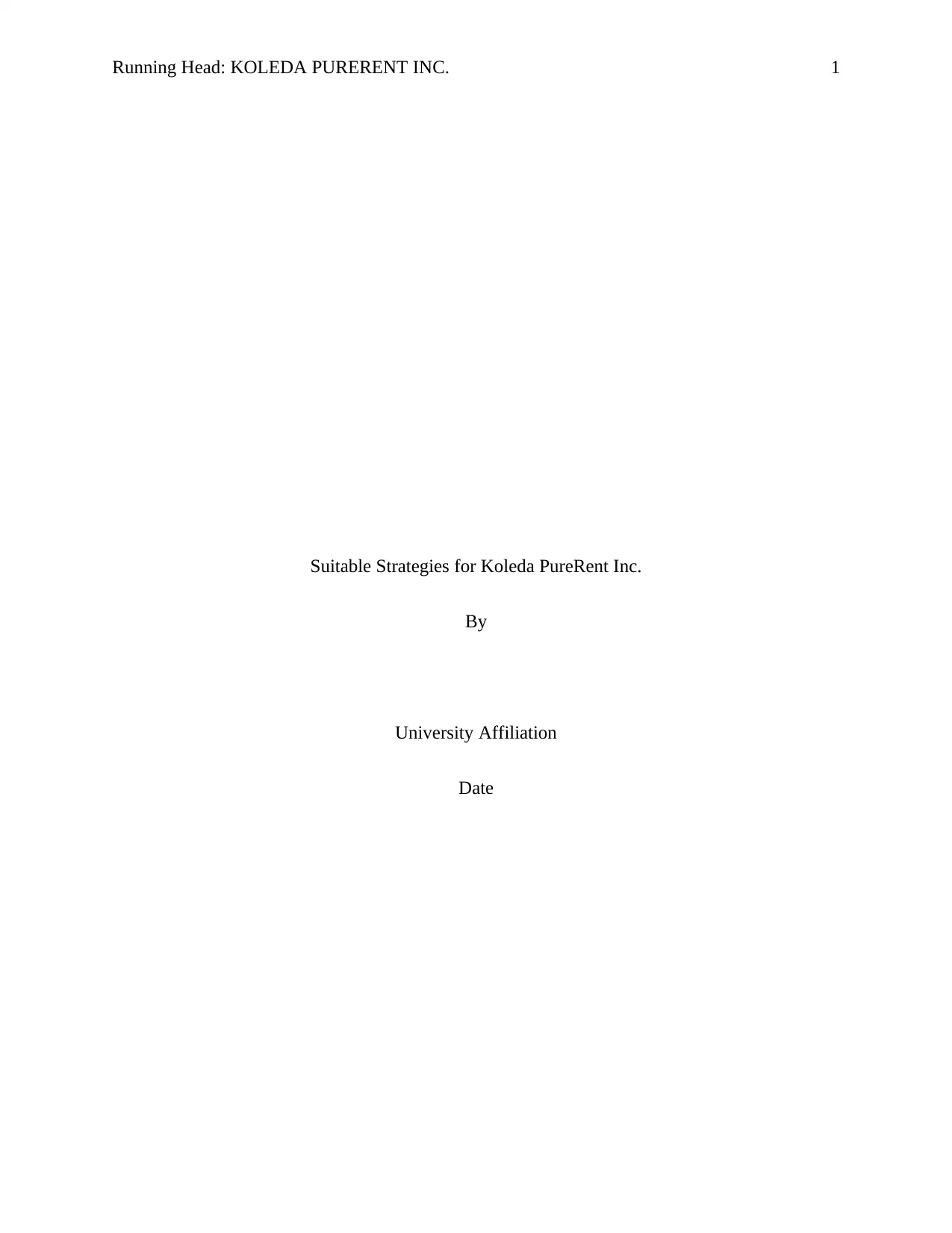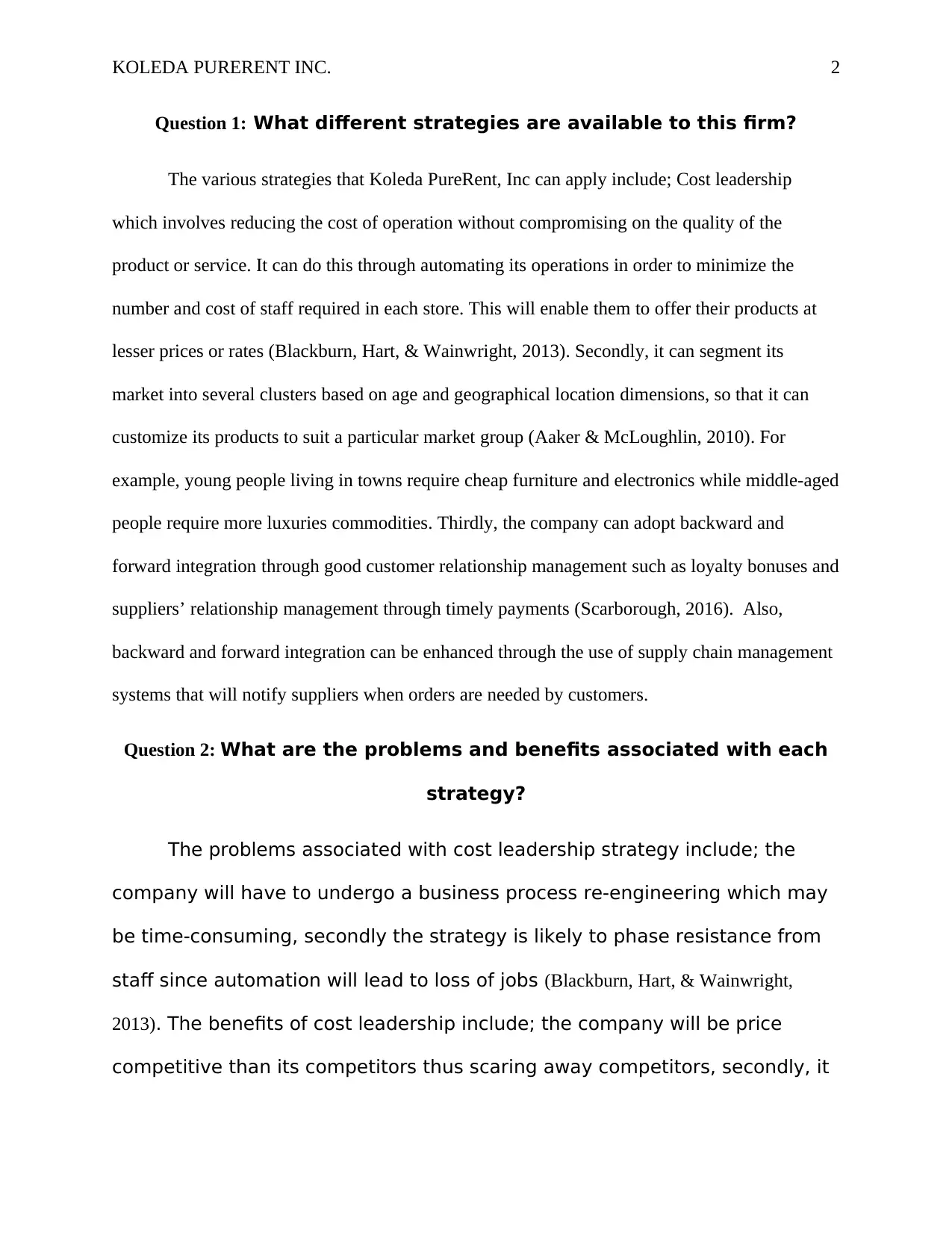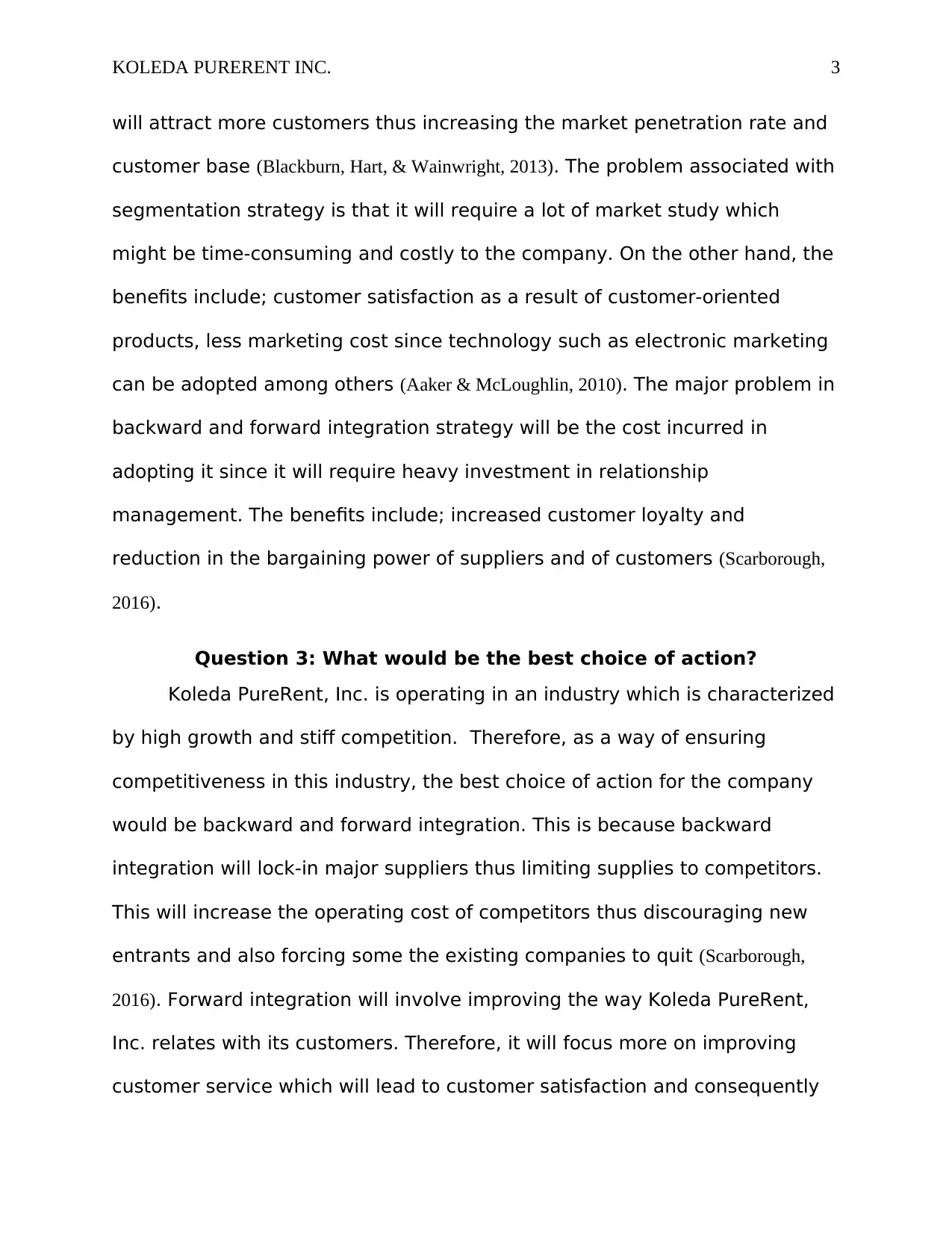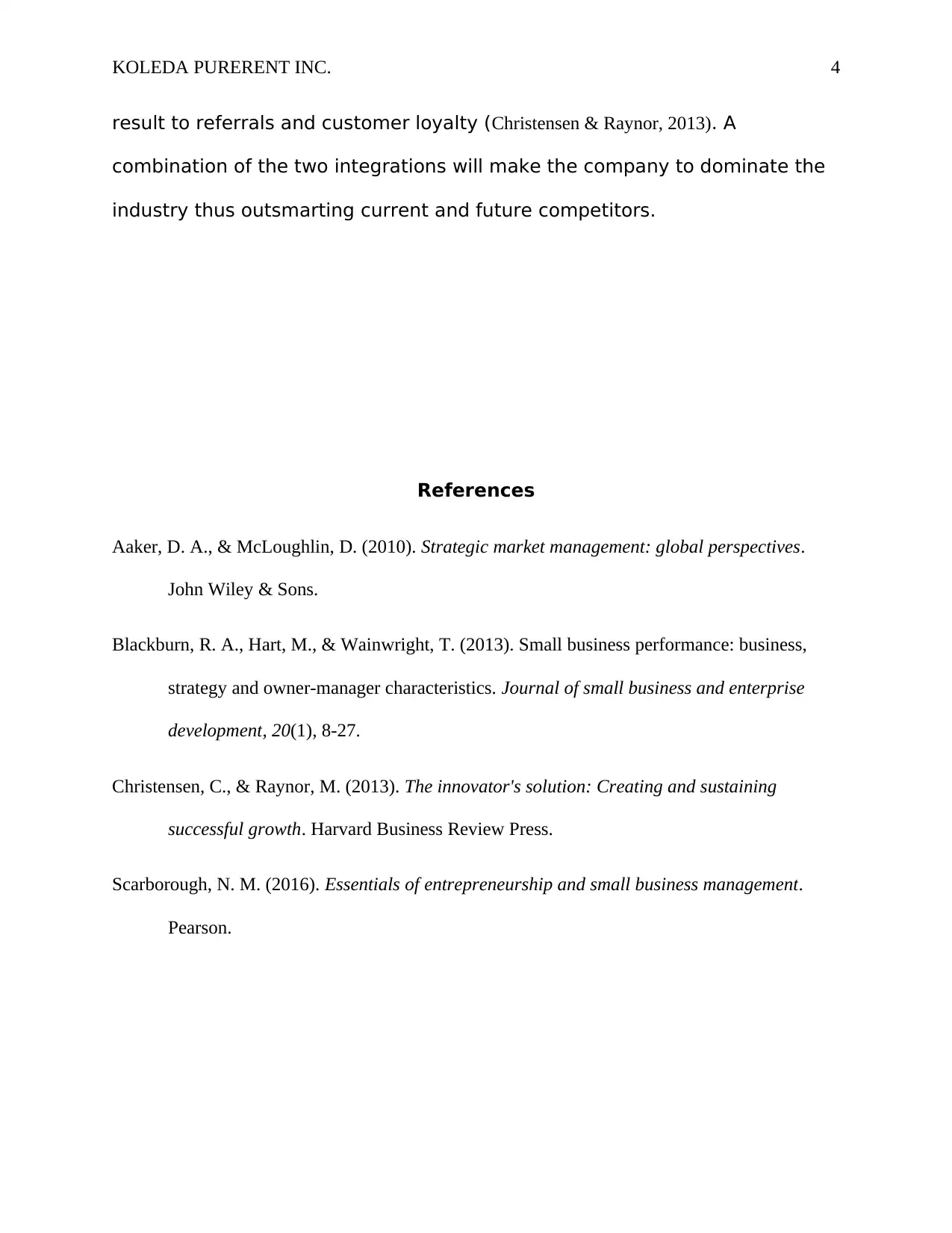MGT101: Strategic Analysis and Recommendations for Koleda PureRent
VerifiedAdded on 2023/06/03
|4
|757
|140
Essay
AI Summary
This essay provides a strategic analysis of Koleda PureRent Inc., exploring various strategies available to the firm, including cost leadership, market segmentation, and backward/forward integration. It discusses the problems and benefits associated with each strategy, ultimately recommending backward and forward integration as the best course of action for Koleda PureRent, Inc. given the industry's high growth and stiff competition. The analysis emphasizes the importance of locking in major suppliers, improving customer service, and dominating the industry through a combination of these strategies. The document is contributed by a student and available on Desklib.

Running Head: KOLEDA PURERENT INC. 1
Suitable Strategies for Koleda PureRent Inc.
By
University Affiliation
Date
Suitable Strategies for Koleda PureRent Inc.
By
University Affiliation
Date
Paraphrase This Document
Need a fresh take? Get an instant paraphrase of this document with our AI Paraphraser

KOLEDA PURERENT INC. 2
Question 1: What different strategies are available to this firm?
The various strategies that Koleda PureRent, Inc can apply include; Cost leadership
which involves reducing the cost of operation without compromising on the quality of the
product or service. It can do this through automating its operations in order to minimize the
number and cost of staff required in each store. This will enable them to offer their products at
lesser prices or rates (Blackburn, Hart, & Wainwright, 2013). Secondly, it can segment its
market into several clusters based on age and geographical location dimensions, so that it can
customize its products to suit a particular market group (Aaker & McLoughlin, 2010). For
example, young people living in towns require cheap furniture and electronics while middle-aged
people require more luxuries commodities. Thirdly, the company can adopt backward and
forward integration through good customer relationship management such as loyalty bonuses and
suppliers’ relationship management through timely payments (Scarborough, 2016). Also,
backward and forward integration can be enhanced through the use of supply chain management
systems that will notify suppliers when orders are needed by customers.
Question 2: What are the problems and benefits associated with each
strategy?
The problems associated with cost leadership strategy include; the
company will have to undergo a business process re-engineering which may
be time-consuming, secondly the strategy is likely to phase resistance from
staff since automation will lead to loss of jobs (Blackburn, Hart, & Wainwright,
2013). The benefits of cost leadership include; the company will be price
competitive than its competitors thus scaring away competitors, secondly, it
Question 1: What different strategies are available to this firm?
The various strategies that Koleda PureRent, Inc can apply include; Cost leadership
which involves reducing the cost of operation without compromising on the quality of the
product or service. It can do this through automating its operations in order to minimize the
number and cost of staff required in each store. This will enable them to offer their products at
lesser prices or rates (Blackburn, Hart, & Wainwright, 2013). Secondly, it can segment its
market into several clusters based on age and geographical location dimensions, so that it can
customize its products to suit a particular market group (Aaker & McLoughlin, 2010). For
example, young people living in towns require cheap furniture and electronics while middle-aged
people require more luxuries commodities. Thirdly, the company can adopt backward and
forward integration through good customer relationship management such as loyalty bonuses and
suppliers’ relationship management through timely payments (Scarborough, 2016). Also,
backward and forward integration can be enhanced through the use of supply chain management
systems that will notify suppliers when orders are needed by customers.
Question 2: What are the problems and benefits associated with each
strategy?
The problems associated with cost leadership strategy include; the
company will have to undergo a business process re-engineering which may
be time-consuming, secondly the strategy is likely to phase resistance from
staff since automation will lead to loss of jobs (Blackburn, Hart, & Wainwright,
2013). The benefits of cost leadership include; the company will be price
competitive than its competitors thus scaring away competitors, secondly, it

KOLEDA PURERENT INC. 3
will attract more customers thus increasing the market penetration rate and
customer base (Blackburn, Hart, & Wainwright, 2013). The problem associated with
segmentation strategy is that it will require a lot of market study which
might be time-consuming and costly to the company. On the other hand, the
benefits include; customer satisfaction as a result of customer-oriented
products, less marketing cost since technology such as electronic marketing
can be adopted among others (Aaker & McLoughlin, 2010). The major problem in
backward and forward integration strategy will be the cost incurred in
adopting it since it will require heavy investment in relationship
management. The benefits include; increased customer loyalty and
reduction in the bargaining power of suppliers and of customers (Scarborough,
2016).
Question 3: What would be the best choice of action?
Koleda PureRent, Inc. is operating in an industry which is characterized
by high growth and stiff competition. Therefore, as a way of ensuring
competitiveness in this industry, the best choice of action for the company
would be backward and forward integration. This is because backward
integration will lock-in major suppliers thus limiting supplies to competitors.
This will increase the operating cost of competitors thus discouraging new
entrants and also forcing some the existing companies to quit (Scarborough,
2016). Forward integration will involve improving the way Koleda PureRent,
Inc. relates with its customers. Therefore, it will focus more on improving
customer service which will lead to customer satisfaction and consequently
will attract more customers thus increasing the market penetration rate and
customer base (Blackburn, Hart, & Wainwright, 2013). The problem associated with
segmentation strategy is that it will require a lot of market study which
might be time-consuming and costly to the company. On the other hand, the
benefits include; customer satisfaction as a result of customer-oriented
products, less marketing cost since technology such as electronic marketing
can be adopted among others (Aaker & McLoughlin, 2010). The major problem in
backward and forward integration strategy will be the cost incurred in
adopting it since it will require heavy investment in relationship
management. The benefits include; increased customer loyalty and
reduction in the bargaining power of suppliers and of customers (Scarborough,
2016).
Question 3: What would be the best choice of action?
Koleda PureRent, Inc. is operating in an industry which is characterized
by high growth and stiff competition. Therefore, as a way of ensuring
competitiveness in this industry, the best choice of action for the company
would be backward and forward integration. This is because backward
integration will lock-in major suppliers thus limiting supplies to competitors.
This will increase the operating cost of competitors thus discouraging new
entrants and also forcing some the existing companies to quit (Scarborough,
2016). Forward integration will involve improving the way Koleda PureRent,
Inc. relates with its customers. Therefore, it will focus more on improving
customer service which will lead to customer satisfaction and consequently
⊘ This is a preview!⊘
Do you want full access?
Subscribe today to unlock all pages.

Trusted by 1+ million students worldwide

KOLEDA PURERENT INC. 4
result to referrals and customer loyalty (Christensen & Raynor, 2013). A
combination of the two integrations will make the company to dominate the
industry thus outsmarting current and future competitors.
References
Aaker, D. A., & McLoughlin, D. (2010). Strategic market management: global perspectives.
John Wiley & Sons.
Blackburn, R. A., Hart, M., & Wainwright, T. (2013). Small business performance: business,
strategy and owner-manager characteristics. Journal of small business and enterprise
development, 20(1), 8-27.
Christensen, C., & Raynor, M. (2013). The innovator's solution: Creating and sustaining
successful growth. Harvard Business Review Press.
Scarborough, N. M. (2016). Essentials of entrepreneurship and small business management.
Pearson.
result to referrals and customer loyalty (Christensen & Raynor, 2013). A
combination of the two integrations will make the company to dominate the
industry thus outsmarting current and future competitors.
References
Aaker, D. A., & McLoughlin, D. (2010). Strategic market management: global perspectives.
John Wiley & Sons.
Blackburn, R. A., Hart, M., & Wainwright, T. (2013). Small business performance: business,
strategy and owner-manager characteristics. Journal of small business and enterprise
development, 20(1), 8-27.
Christensen, C., & Raynor, M. (2013). The innovator's solution: Creating and sustaining
successful growth. Harvard Business Review Press.
Scarborough, N. M. (2016). Essentials of entrepreneurship and small business management.
Pearson.
1 out of 4
Related Documents
Your All-in-One AI-Powered Toolkit for Academic Success.
+13062052269
info@desklib.com
Available 24*7 on WhatsApp / Email
![[object Object]](/_next/static/media/star-bottom.7253800d.svg)
Unlock your academic potential
Copyright © 2020–2025 A2Z Services. All Rights Reserved. Developed and managed by ZUCOL.





